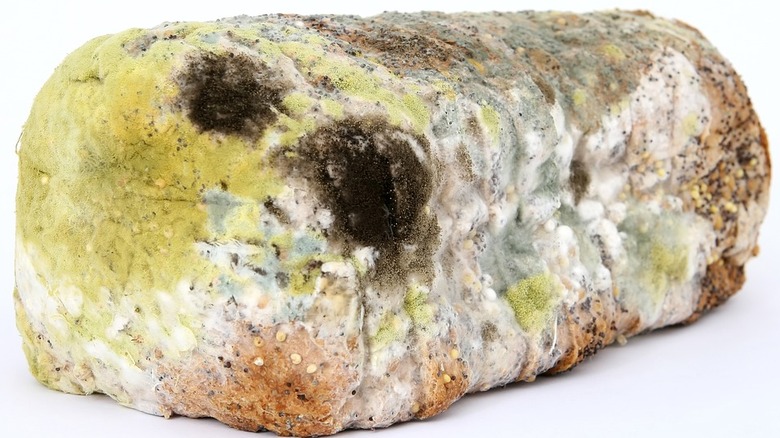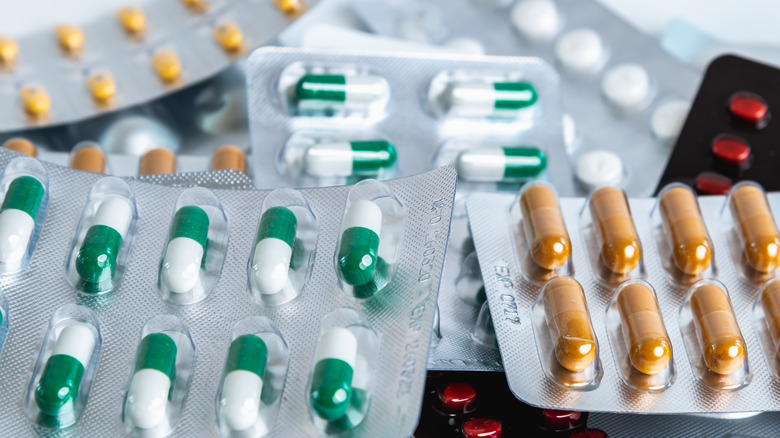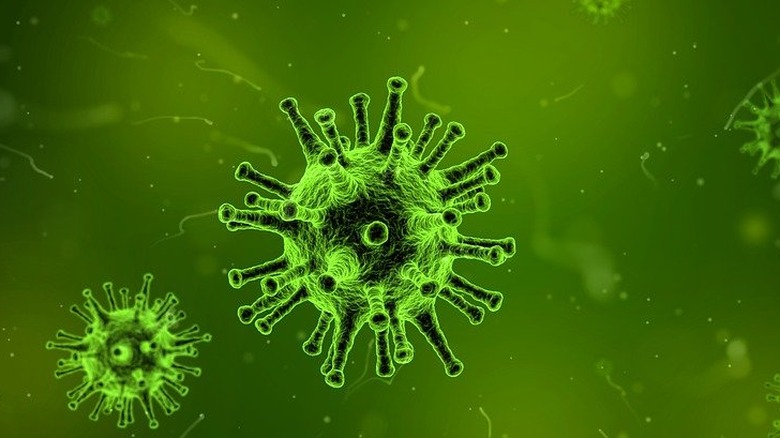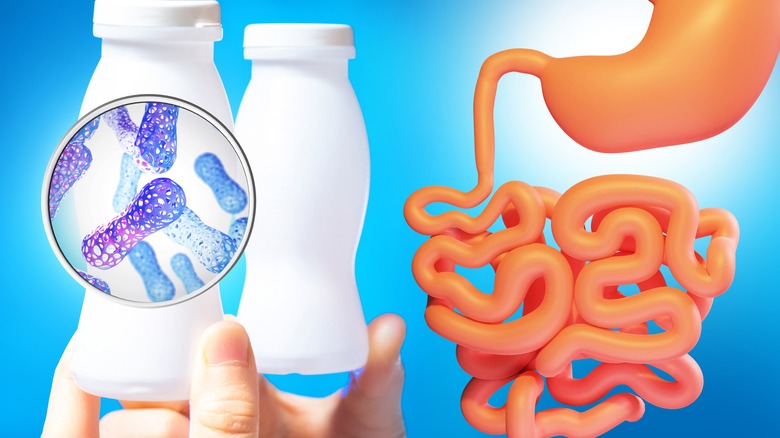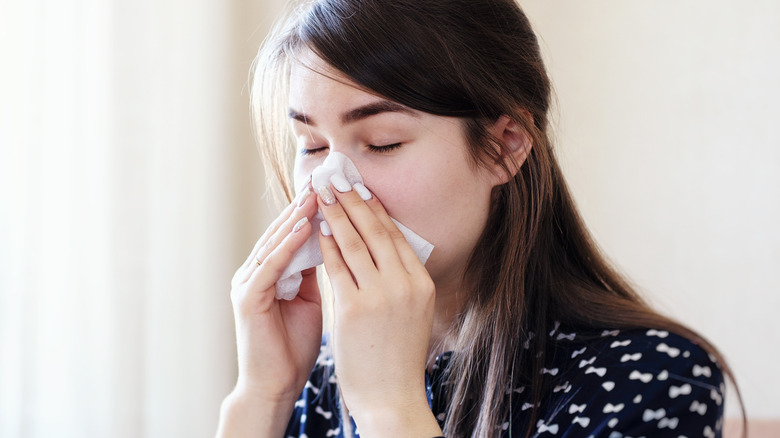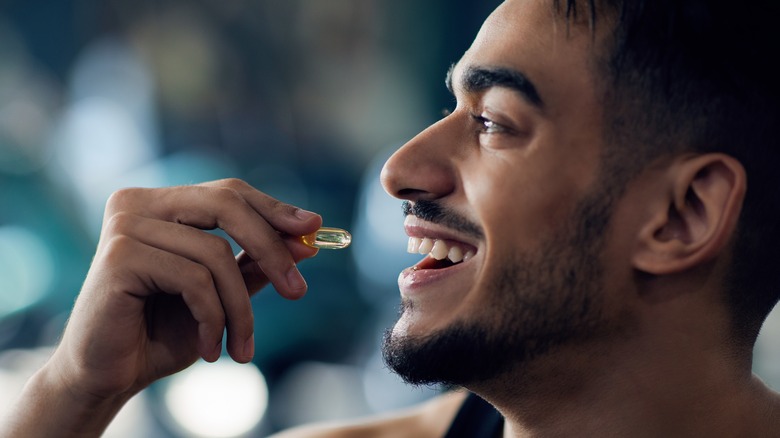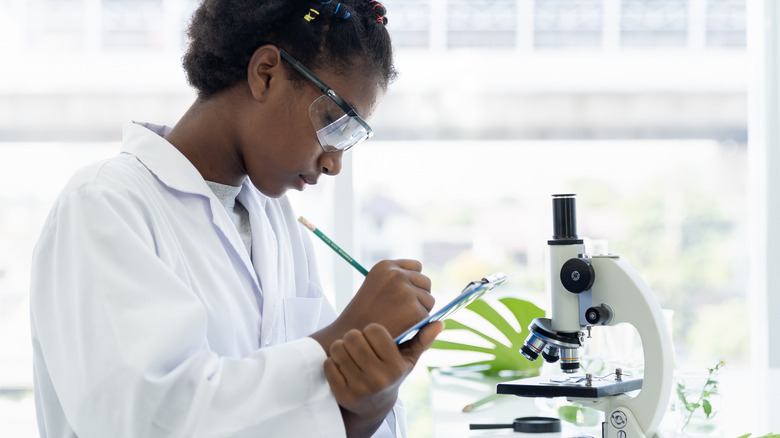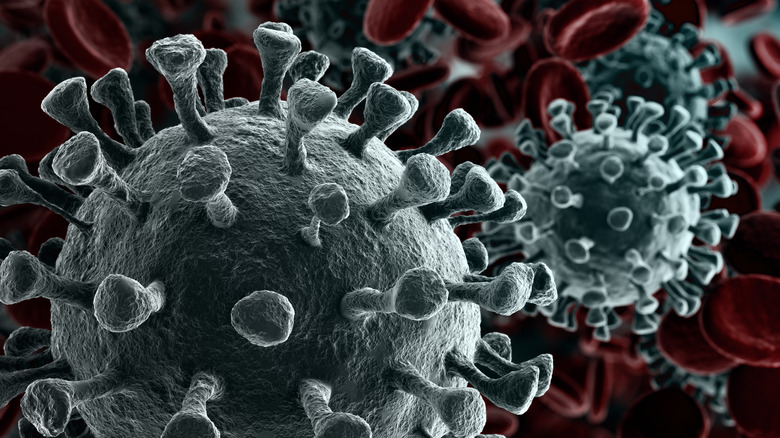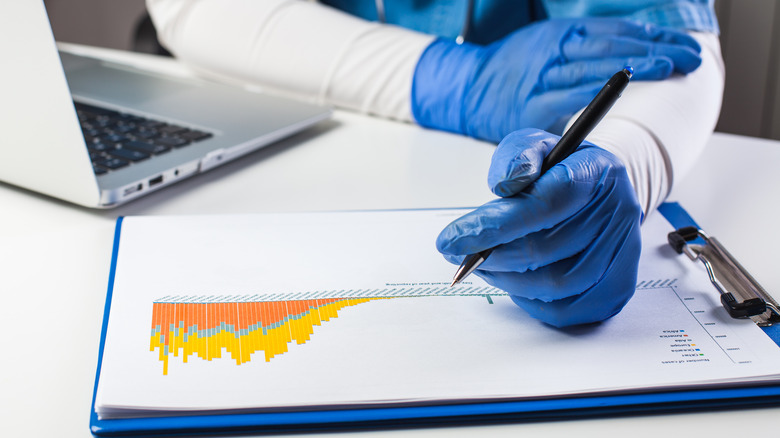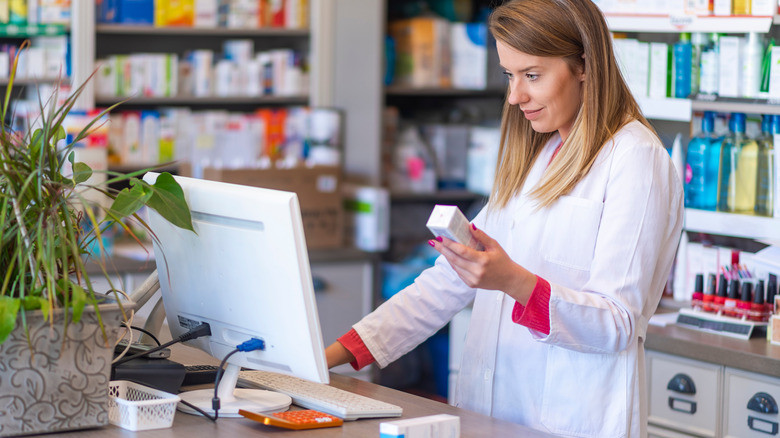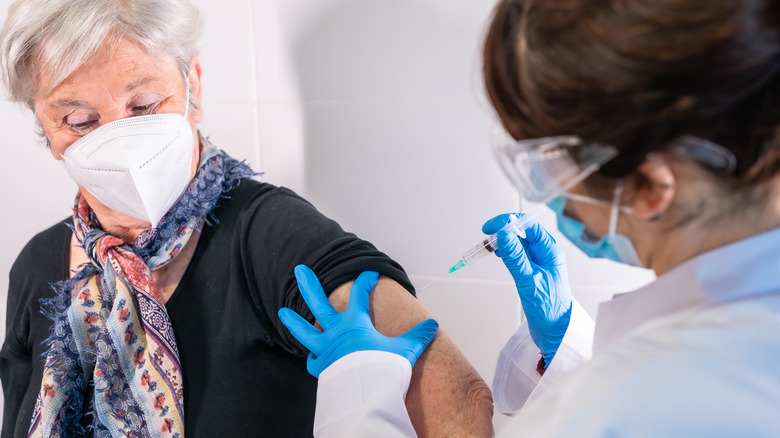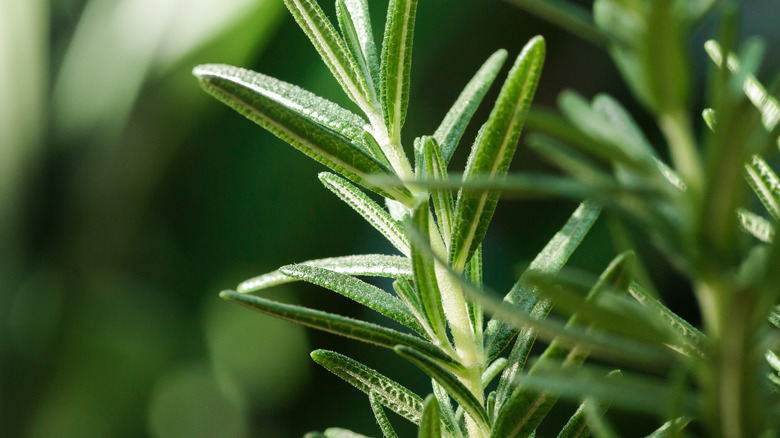Things You Might Not Know About Antibiotics
Antibiotics are an important part of our healthcare system. Without them, we'd be subject to bacterial infections of all kinds. According to HealthDirect Australia, bacteria can enter our bodies through our airways or cuts on our skin, but either type of infection can cause fever, fatigue, headache, nausea, and vomiting.
As the CDC explains, antibiotics are drugs designed to treat bacterial infections in both humans and animals. They fall into two main categories: Some antibiotics are said to kill bacteria directly (bactericidal), and some are said to simply stop them from multiplying and continuing to grow (bacteriostatic). A systematic literature review from Clinical Infectious Diseases suggests that bacteriostatic antibiotics kill bacteria too (albeit in smaller numbers than bactericidal antibiotics) and that both types of antibiotics have been shown to be equally effective at treating bacterial infections.
That said, not all bacteria are harmful. In fact, some play a crucial role in our bodies. The NIH estimates that microorganisms outnumber our own body cells by about 10 to 1. Of course, these microorganisms are much smaller than our body cells, so they only take up about 1-3% of our body mass. However, they have an enormous influence over our health and wellbeing. This raises the question of whether or not bacteria-killing antibiotics have the potential to do more harm than good. With this in mind, it's helpful to learn a little bit more about antibiotics, what sort of risks are associated with them, and how to use them responsibly.
The first antibiotics were made from mold
An ancient Egyptian text suggests that moldy bread was once used to dress wounds in order to keep them from getting infected (via the New York Times). Without knowing it, the ancient Egyptians seem to have discovered penicillin. Mold is a type of fungus, and the specific molds that grow on bread are known to kill a variety of harmful bacteria.
While people have been using bread mold and other natural antibiotics to treat bacterial infections for several millennia, it wasn't until 1928 that the specific fungus Penicillium notatum was isolated and shown to effectively kill bacteria, according to the Microbiology Society. Alexander Fleming accidentally contaminated a culture of Staphylococcus bacteria (which causes staph infections) with some of this fungus and noticed that the fungus wiped out the bacterial culture. After extensive experimentation and clinical trials, this discovery ultimately gave rise to the creation of penicillin — and of antibiotics as a class of drug.
The advent of antibiotics was groundbreaking: Bacterial infections that were once deadly could now be treated. However, it's important to recognize that the success of antibiotics has come at a cost, given the rise of antibiotic-resistant bacteria. A 2009 study from Nature Reviews Microbiology describes Staphylococcus aureus, traditionally treated with penicillin, as "notorious" at evolving resistance to antibiotics. Extensive use of antibiotics puts us in a perpetual evolutionary arms race against bacteria, according to an article published by Harvard University.
Different antibiotics treat different bacterial infections
In general, there is no single antibiotic drug that kills every type of bacteria, according to a book about antibiotics from StatPearls. This is partly because different antibiotics are designed to target different types of bacteria, but it is also partly a result of antibiotic resistance — when bacteria evolve to resist the specific antibiotics designed to kill them. In any case, the type of antibiotic that gets prescribed to treat an infection will depend on what type of infection it is.
For instance, MedlinePlus says penicillin is traditionally used to treat respiratory infections such as strep throat, scarlet fever, and infections of the ears, skin, and mouth. Cephalosporins are a different type of antibiotic, and these are used to treat urinary tract infections, sinus infections, some skin infections, meningitis, and gonorrhea (per Healthline). Meanwhile, tetracyclines — another class of antibiotic — are used for infections of the skin, eyes, genitals, lymph, and intestines, as well as respiratory tract infections (via RxList).
Whether bacteria is gram-positive or gram-negative is also a factor in determining which antibiotics will be effective. As a study from the journal Molecules explains, gram-negative bacteria have additional layers of protection and are more resistant to many types of antibiotics than gram-positive bacteria. Thankfully, some antibiotics do work against gram-negative bacteria. The antibiotics known as aminoglycosides are especially effective against gram-negative bacteria, according to the American Academy of Family Physicians.
Antibiotics kill harmful bacteria, but some also kill beneficial bacteria
A less prominent side effect of antibiotic use is the collateral damage it exerts on the gut microbiome, according to a review article published in Frontiers in Cellular and Infection Microbiology. A complex web of "metabolic interdependencies" governs the relationship between the community of bacteria living in the intestine and the intestine itself. We now know that the basic functioning of this organ depends on healthy colonies of various helpful bacteria, but it isn't the only organ that depends on such bacteria.
The article also explains the connection between the microbiome and the immune system. The authors estimate that our intestines produce roughly 80% of all the antibodies we need to fight infections. Furthermore, the specific species of bacteria in our intestinal tract are largely responsible for distinguishing harmful pathogens from other helpful species of bacteria. When our helpful intestinal bacteria get compromised (e.g., from antibiotics that indiscriminately kill some of them), this can create an imbalance. Some helpful species may remain, but the population will be significantly less diverse. It may take up to a month or two for the former population to be restored.
Another study from the Archives of Medical Research mentions that the GI tract contains more helpful bacteria than any other part of our body, and it is very sensitive to a variety of external factors that can disturb its finely-tuned balance — including antibiotics and other drugs.
Antibiotics are recommended to be taken with probiotic foods
A study from Nature found that certain classes of antibiotics (tetracyclines and macrolides) kill some of the beneficial intestinal bacteria responsible for fighting certain harmful bacteria, leaving us susceptible to repeat infections from this harmful bacteria. However, antibiotics are sometimes necessary for treating serious infections, so it's important to consider what we can do to mitigate the damage done to our intestinal tract and other populations of helpful bacteria on those occasions when we need to take them.
Some experts recommend taking them alongside probiotic foods, according to Healthline. Many foods have beneficial bacteria – yogurt, sauerkraut, kimchi, tempeh, kefir, kombucha, etc. — but probiotics can also come in pill or powder form. The American Academy for Family Physicians has found substantial evidence that taking probiotics can be effective in the treatment of some of the side effects associated with antibiotic use, including antibiotic-associated diarrhea.
Registered dietician Becky Bell recommends supplementing your diet with multiple strains of healthy bacteria when taking antibiotics (via Healthline). She specifically highlights Lactobacillus acidophilus, which is found in many yogurts, but points out that the best thing you can do is eat a variety of these foods to make sure you're replenishing all the bacteria you need.
Antibiotics can't treat colds or flu
While antibiotics treat infections caused by bacteria, they can't treat infections caused by viruses, fungi, or other parasites. An article from Johns Hopkins Medicine outlines the practical difference between bacteria and viruses: Bacteria primarily cause strep throat, urinary tract infections, sinus infections, and most ear infections. Meanwhile, viruses are responsible for the common cold (a class of viruses known as coronaviruses), the flu, most coughs, and most sore throats. While the symptoms of bacterial infection and viral infection are often similar, it's crucial to distinguish between them for the sake of treating them.
Antibiotics can't treat viral infections, but they can still wipe out your helpful bacteria, making them a potentially risky treatment when the source of the infection is unclear. However, a book about antibiotics from StatPearls claims that antibiotics are frequently prescribed even before the official diagnosis of the infection is confirmed. The authors refer to this as "empiric therapy," and while it's sometimes necessary when an infection is life-threatening, it also has the potential to contribute unnecessary side effects.
When possible, it's best to get a bacteria culture test to determine whether or not the infection you have is bacterial before beginning a course of antibiotics. Note that these tests won't tell you if you have a viral infection, but you can also get a viral test to know for sure.
Antibiotics are sometimes used preventively
The National Health Service of the U.K. explains that antibiotics can be prescribed in certain situations before a bacterial infection has even developed, known as antibiotic prophylaxis. For instance, animal bites create wounds that have been exposed to a wide variety of pathogens and are likely to become infected, and doctors may prescribe antibiotics in such cases to prevent infection. Preventive antibiotics may also be used for invasive surgeries that have a high likelihood of causing infection, as well as certain health conditions such as sickle cell anemia and chemotherapy treatment for cancer.
Antibiotics are also sometimes used to prevent malaria. Before traveling to a place where malarial infection is common, you may be prescribed the antibiotic doxycycline. The CDC notes that a course of doxycycline to prevent malaria should begin a day or two before traveling, and it needs to be taken every day of your travels and for an additional 28 days after coming back home.
However, a study from Nature found that doxycycline also killed some of the beneficial intestinal bacteria, so it is not without side effects. There are other drugs that are used to prevent malaria, and depending on specifically where you're traveling, how high your risk will be, and other potential factors, you may consider a different treatment to prevent malaria (or none at all). Taking a preventive drug may not be necessary, even if you travel to a place where malaria is more common.
As many as 1 in 3 antibiotic prescriptions may be unnecessary
The CDC estimates that one-third of all antibiotic prescriptions might not have been necessary. They claim most unnecessary prescriptions for antibiotics are the result of mistaking viral infection for bacterial infection (i.e., using antibiotics to treat a cold or flu). These needless prescriptions don't treat the underlying infection and trigger a variety of side effects, such as eliminating some helpful bacteria.
One of the crucial strategies the CDC mentions to help solve this problem is "watchful waiting" or "delayed prescribing" until a diagnosis is confirmed. Whenever possible (such as when an infection is not life-threatening), tests should be done to determine the cause of the infection before anything gets prescribed. Viral treatments are completely separate from antibiotics. They can't treat bacterial infections, just as antibiotics can't treat viral infections.
The CDC goes on to explain that working to reduce the number of unnecessary antibiotic prescriptions is vital in the fight against antibiotic resistance. Harmful bacteria naturally develop antibiotic resistance the more they're used, so using them when they're unnecessary has the potential to needlessly accelerate this process.
Antibiotic resistance has been called "the greatest risk to human health"
In 2013, the World Economic Forum (WEF) claimed that the greatest risk to public health could be antibiotic-resistant bacteria, as described in a study from the New England Journal of Medicine. The study explains that antibiotic resistance occurs all the time, whether or not antibiotics are prescribed "appropriately." Even if we were to eliminate all unnecessary antibiotic prescriptions, this process would still be happening: It's inevitable with any use of antibiotics. Bacteria have evolved alongside all manner of natural antibiotics (e.g., some types of mold) for longer than humans have been around, and the use of antibiotics can artificially select for already-existing strains of bacteria that have evolved resistance.
The problem is that bacteria are able to evolve new strains faster than we can develop new antibiotics, and using new antibiotics just accelerates this process, as an article published by Harvard University explains. The article suggests the problem is worsened by inappropriate and unnecessary antibiotic prescriptions. It also points out that "antibiotics can hurt the good guys, too," referring to the diverse population of beneficial bacteria in the gastrointestinal tract.
A book about antibiotics from StatPearls clarifies that antibiotic-resistant bacteria can have either "intrinsic" or "acquired" properties that protect it from the antibiotic. It's said that bacteria that isn't targeted by a specific antibiotic has intrinsic resistance, whereas acquired resistance is the result of bacteria evolving resistance to antibiotics that used to be effective against them.
Antibiotic-resistant infections cause 35,000 deaths in the U.S. each year
A 2019 report from the CDC found that over 2.8 million antibiotic-resistant infections occur every year in the United States. Of those, 35,000 are fatal. That's roughly a 1.25% fatality rate for these infections. For comparison, it's very similar to the fatality rate from COVID in the U.S., which is about 1.2% as of 2022 (via Johns Hopkins Medicine). It's a high enough rate to be cause for alarm.
The Mayo Clinic details the process in which some bacteria survive a course of antibiotics, and those survivors multiply and pass on their antibiotic-resistant trait to more bacteria. In fact, some antibiotic-resistant bacteria can facilitate the development of antibiotic resistance in other bacteria. The Mayo Clinic notes that this process is "normal and expected," but how quickly the process happens is a function of how often and in what ways the drugs are used.
While it's reasonable to be concerned about your own use of antibiotics, a popular misconception is that individual people develop resistance to antibiotics. However, as Johns Hopkins Medicine explains, it's the bacteria that evolve, not you. Taking antibiotics excessively can accelerate this process, but it won't make you as an individual any more susceptible to antibiotic-resistant bacteria than anyone else.
Antibiotics in livestock feed are a major contributor to antibiotic resistance
Perhaps you're already aware of the ample evidence to suggest antibiotic resistance is a major public health problem. However, one of the most important and overlooked avenues to antibiotic resistance is the use of antibiotics in preventing infections in livestock. A review from Public Health Reports identifies the overuse of antibiotics in livestock as a significant threat to antibiotic resistance. The authors detail exactly how this happens: When antibiotics are used, some bacteria with resistance can transfer their resistance to other species. This is particularly problematic in the case of livestock, as these antibiotic-resistant bacteria end up in our food system.
A review from the International Journal of Zoonoses explains how excess use of antibiotics in animals can accelerate the evolution of antibiotic-resistant bacteria, and how both antibiotics as well as antibiotic-resistant bacteria have been found in meat and milk. The authors specifically mention transferable drug resistance (TDR) happening across several different species of bacteria, including E. coli and Salmonella, in the production of meat. Worse still, once in the food system, these antibiotic-resistant bacteria can contaminate other foods.
In 2021, the CDC identified 17 outbreaks of E. coli, Salmonella, or other antibiotic-resistant bacteria in our food system, leading to widespread contamination and recalls of various food products. In order to slow the recurrence of these kinds of outbreaks, it's crucial for livestock farmers to use antibiotics sparingly and improve the unhygienic conditions that give rise to bacterial infections.
Not finishing your antibiotics won't actually contribute to antibiotic resistance
You may have heard that not finishing a course of antibiotics can contribute to antibiotic resistance. You might feel significantly better after just a few days and think you don't need to take the antibiotics anymore, but the antibiotics haven't finished killing all the bacteria, and the bacteria still left behind are likely to develop resistance and multiply, creating an even worse infection than what you started with — or so the thinking goes.
In reality, however, this isn't supported by evidence. A study from the British Medical Journal didn't find sufficient evidence to conclude that stopping antibiotics early can contribute to antibiotic resistance. On the flip side, the authors point out that taking antibiotics for longer than they're prescribed can actually contribute to antibiotic resistance.
In light of this evidence, public health messaging is starting to change. While public health campaigns have long urged people to keep taking antibiotics even after they feel better, the messaging now focuses on taking antibiotics "exactly as prescribed." This is an important distinction, because it leaves room for nuance and situation-specific recommendations your doctor may make, and the possibility of working with your doctor to determine how long you need to continue your course of antibiotics.
Monoclonal antibody treatment may replace antibiotics in the treatment of certain infections
In light of antibiotic resistance, many doctors and researchers are working on alternative therapies for bacterial infections. A study from Current Opinions in Infectious Disease suggests that the use of monoclonal antibodies is a promising new treatment for bacterial infection. As the researchers explain, the basic idea is to use our adaptive immune response to our advantage, identifying antibodies that protect against antibiotic-resistant bacteria and then cloning them. These aren't antibodies that already exist, but antibodies that are developed in drug labs to specifically target bacteria that have developed antibiotic resistance.
This type of treatment is still new, and it will take a while for research and clinical trials to catch up. Still, the researchers suggest that these treatments could one day be the go-to treatment for bacterial infections, while antibiotics would play more of a supporting role. An article from Nature similarly argues monoclonal antibodies have the potential to not only replace antibiotic treatment but specifically treat antibiotic resistance, something antibiotics can never do. In other words, they have the potential to be a more effective and less harmful treatment for bacterial infections. This presents a hopeful direction for the future not only of bacterial infection, but of medicine in general, as monoclonal antibodies are being used in other applications as well.
Some herbal treatments may be just as effective as antibiotics
In the interest of limiting the use of antibiotics, researchers have studied some herbal therapies. A study from Global Advances in Health and Medicine looked at small intestinal bacterial overgrowth (SIBO) and compared rifaximin (an antibiotic) with commercially available herbal supplements designed to target SIBO. The study found the herbal therapy to be just as effective as the antibiotic in the treatment of SIBO.
Important to note is that this was not a randomized trial, as participants were given the option of which sort of treatment they wanted to try. 67 participants chose the antibiotic, while 37 participants chose the herbal treatment. There was also a gender skewing, with a larger proportion of the antibiotics group comprising men and a larger proportion of the herbal treatment group comprising women. The authors acknowledge the limitations inherent in a study that isn't controlled and point out that diet also wasn't controlled (and diet is known to impact SIBO), but the evidence remains promising that herbal treatments may prove to be just as effective as antibiotics.
In general, though, further research needs to be done. As we move past widespread use of antibiotics to treat and prevent infection, alternative therapies like herbal remedies should be rigorously tested.
Certain foods have natural antibacterial properties
Certain foods are also known to have natural bacteria-fighting properties. As noted in an article from the New York Times, some of this knowledge is ancient: In addition to stumbling upon penicillin, the ancient Egyptians also used honey to treat wounds. Raw honey is known to naturally kill bacteria, and it also has a natural pain-killing compound that is similar to aspirin on a chemical level.
A study from the Mymensingh Medical Journal found raw honey could be useful in the treatment of E. coli infections. In the highest concentrations, raw honey was found to be just as effective at treating E. coli infections as the antibiotic tetracycline — and significantly more effective than commercial honey. Another study from the journal Wounds suggests there is sufficient clinical evidence to support the use of honey as a topical treatment to prevent infection from wounds.
Many other foods have similar properties. These are known as functional foods, or foods that contain beneficial compounds that have functions beyond their nutritional value. Per Healthline, other natural antibiotic foods include garlic, thyme essential oil, oregano essential oil, and myrrh extract. A study from the International Journal of Physiology, Pathophysiology, and Pharmacology also found the active components of ginger to have antibacterial properties. Such foods are particularly promising in both treating and preventing antibiotic infections, as they have virtually no side effects. They may contribute additional health benefits as well.


